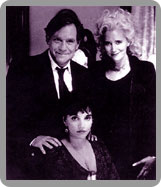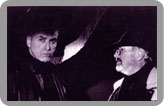
TELEVISION REVIEWS
Picture Windows
LIGHTNING;
ARMED RESPONSE;
TWO NUDES BATHING
(Sun. (29). 8-10:30p.m., Showtime)
Filmed in Los Angeles, Toronto and Anjou,
France, by Yorktown Prods, in association with Skyvision Partners.
Executive producers, Norman Jewison, Gayle Fraser-Baigelman, Howard
Rosen; producers, Scott JT Frank, Dan Halperin, David Wesley Wachs;
supervising producer, Jeff Freilich; series creators, Frank, Halperin,
Wachs.
"Lightning"
Director, Joe Dante; writer, Jim Bymes, based
on a short story by Zane Grey; camera, Jamie Anderson; editor, David
Hickes; production design, Nanette Vanderbilt; sound, Geoffrey Patterson;
music, Hummie Mann.
"Armed Response"
Director, Bob Rafelson; writer, Fredric Rafael,
based on his story "Merce"; camera, Miroslaw Baszak; editor,
Lorenzo Massa; production design, Valanne Ridgeway; sound, Doug
Johnson; music, Hummie Mann.
"Two Nudes Bathing"
Director-writer-producer, John Boorman; camera,
Seamus Deasy; editor, Ron Davis; art director, Derek Wallace; sound,
Brendan Deasy; music, Jocelyn West.
Casts: "Lightning": Brian Keith,
Kathleen Quinlan, Ron Perlman, Henry Jones;'' Armed Response ":
Robert Loggia, James Calvert, Steve Zahn, Cyndy Preston, Cliff Saunder,
Maria Macratsis, Laura Press; "Two Nudes Bathing": John
Hurt, Charley Boorman, Juliette Caton, Angeline Ball, Britta Smith,
Jocelyn West.
Big-name helmers have crafted small-screen jewels for Showtime's
"Picture Windows" short-film series. Literary/arty pretensions
of theme - each pic is inspired by a work of art or classic literature
- gives the series a rather higher-brow feel, which, thankfully, doesn't
spell filmmaker self-indulgence. First trilogy showcased Peter Bogdanovich,
Jonathan Kaplan and Norman Jewison (one of the series' exec producers);
second trilogy features pics from Joe Dante, Bob Rafelson and John
Boorman; all are worthy and worth a good look.
Based on a Zane Grey story and visually inspired
by the works of Frederick Remington, "Lightning" - Dante's
offering - top - lines Brian Keith as an ornery gold prospector
who strikes it rich.
His life is saved by Lightning, a recently purchased mule who seems
to possess preternatural intelligence - at least for a mule. Ron
Perlman and Kathleen Quinlan are a gambler and whore, respectively,
who plot to take his gold. Story trades on an O. Henry type of irony
with a twisted, satisfying conclusion.
Dante directs this wry shortie with a sure
hand. Keith, Perlman and Quinlan are relaxed, and production values
are tops.
Rafelson's entry, "Armed Response,"
takes off from the David Hockney painting "Portrait of an Artist
(Pool With Two Figures)," with all the post-modern chilliness
that painting embodies.
Fabulously wealthy lawyer Robert Loggia discovers
that surfaces are misleading and that digging deeper reveals a lurid,
sordid underbelly to his "perfect'' family. In the end, Loggia
is painted into a corner by his kids - closing shot drives the point
home.
Visually, Rafelson keeps "Armed Response"
looking like a cinematic Hockney, bolstering pic's theme.
Boorman's "Two Nudes Bathing" was
well-received when it debuted in Cannes in Un Certain Regard. The
strongest of the trio, "Bathing" is Boorman's witty musing
on how that famous anonymous painting from the 16th century, which
hangs in the Louvre, came to be.
Gorgeously filmed by Seamus Deasy in a French
chateau, "Bathing" assumes a sweet fairytale quality with
helmer's son Charley Boorman portraying the "anonymous"
painter Henri, commissioned to paint the two daughters of a tyrannical
nobleman. Henri educates the girls about love and finds love himself
with the saucy maid.
The beautiful Juliette Caton and Angeline
Ball give the sisters a wonderful aching curiosity about love and
sex; rest of cast, including John Hurt as the comte, are top-notch,
as are tech credits.
- Carole Horst

LEISURES ARTS
Masterpieces Theater
By ROBERT GOLDBERG
Every summer for the past 63 years,the town of Laguna Beach, Calif.,
has hosted what it calls the Pageant of the Masters. The crowds jam
in, the curtain pulls back and there, under the lights, is the evening's
entertainment: a genuine re-creation of an old master artwork, with
real people. For five frozen minutes the actors stand there, locked
in position as "The Last Supper" or "St. George and
the Dragon." Nobody's been able to figure out the purpose of
this pageant, but it's been astounding audiences for more than six
decades.
This week Hollywood goes Laguna Beach one better in the new anthology
series "Picture Windows" (Showtime, Sunday, 8-9:30 p.m.
EDT). A trilogy of half-hour episodes inspired by famous paintings,
"Picture Windows" aims to 'tell the stories behind the tableaux,
to bring the pictures to life-which is, depending on how you look
at it, either an intriguing formalistic conceit or a really silly
idea. But the level of talent behind the camera instantly elevates
this series, for "Picture Windows" calls upon top
Hollywood directors Peter Bogdanovich, Bob Rafelson, John Boorman,
Joe Dante and Jonathan Kaplan under executive producer Norman Jewison
to interpret the works of Botticelli and Degas, Hopper (Edward, not
Dennis or Hedda) and Hockney. With so many big names packed into the
same place, how can the results be anything other than wildly uneven
. . . and well worth a look. There is an emptiness to Hopper's paintings
that lends itself to story-telling-a spare, introverted melancholy
that seems to call out for an explanation. That's the case of "Soir
Bleu," directed by Norman Jewison, the story of an unhappy love
triangle set backstage at a circus. In this rendering of the "II
Pagliacci" tale, the sad clown Tully (Alan Arkin) is in love
with the wife of his friend and rival, the impresario Carl (Dan Hedaya).
Under all the festive makeup, the passion that burns below is sure
to bring a bad end.
 The
story that unfolds is unsurprising but well played. You can guess
every turn in this tears-of-a-clown tale, but Mr. Arkin brings tragic
weight to his Tully. Above all, Mr. Jewison gives the story a great
patina: His palette glows with great nocturnal hues-rich shades of
black and brown. In all, an obvious tale, done with panache. The
story that unfolds is unsurprising but well played. You can guess
every turn in this tears-of-a-clown tale, but Mr. Arkin brings tragic
weight to his Tully. Above all, Mr. Jewison gives the story a great
patina: His palette glows with great nocturnal hues-rich shades of
black and brown. In all, an obvious tale, done with panache.
Moving from tragedy to farce, Peter Bogdanovich's "Song of Songs"
doesn't exactly play by the rules of the game. His reference to Botticelli's
"Primavera" is glancing at best, for the picture is simply
stuck in the window of a naughty lingerie shop that opens in a Greek
neighborhood. Bakery owner Theodore (George Segal) is outraged at
first, then enticed into an affair with sexy shop owner Blossom (Sally
Kirkland): "She's the kind of woman Helen of Troy must've been
... the kind that starts wars." "Song of Songs" is
light comedy played ever so broadly, with as little connection to
reality as to Botticelli. Blossom spurs Theodore on: "You took
me like a warrior, returning to his lover after a long campaign."
Jonathan Kaplan's "Language of the Heart" draws on the shimmering,
luminous colors of Degas's ballet-school pastels, especially "The
Rehearsal." A period drama set in the early 20th century, "Language
of the Heart" follows the story of Anna (Tamara Gorski), a beautiful
young dancer in the corps de ballet. The maestro (Michael Lerner)
tries to seduce her - "adagio . . . allegro . . . crescendo!
"-but she's fallen in love with a penniless but dashing street
violinist (Joel Bissonnette). And when the orchestra's first violinist
breaks his arm, there's only one way this sentimental episode can
turn out.
At its best and at its worst, "Language of the Heart" is
like the picture that inspired it-the segment radiates with the warm
orange light of Degas, and the elegant lines of the dancers. Even
the slums are stylized, airy, lovely. In a way, this episode sums
up the graces and the faults of the entire series, for like the other
"Picture Windows," it is as polished and attractive as the
stories are formulaic and trite.
 The
half-hour format is not easy, especially for feature directors. Like
a short story for the screen, it has its own rules, its own demands.
The segment must be big enough to carry our attention but small enough
to be wrapped up at the end of the 30 minutes. The second trilogy
(to be broadcast Oct.29) uses the format to slightly greater effect,
especially Bob Rafelson's enigmatic "Armed Response "-which
examines the tensions that lie beneath the glittering surface of David
Hockney's pool paintings-and my personal favorite, John Boorman's
"Two Nudes Bathing," the story behind the strange, anonymous
16th-century painting of two young women in a tub. "Two Nudes
Bathing" is a lively period drama, filmed in the south of France
(with John Hurt and Charley Boorman, the director's son) that boasts
sprightly writing, lush production values and several jaunty plot
twists. The
half-hour format is not easy, especially for feature directors. Like
a short story for the screen, it has its own rules, its own demands.
The segment must be big enough to carry our attention but small enough
to be wrapped up at the end of the 30 minutes. The second trilogy
(to be broadcast Oct.29) uses the format to slightly greater effect,
especially Bob Rafelson's enigmatic "Armed Response "-which
examines the tensions that lie beneath the glittering surface of David
Hockney's pool paintings-and my personal favorite, John Boorman's
"Two Nudes Bathing," the story behind the strange, anonymous
16th-century painting of two young women in a tub. "Two Nudes
Bathing" is a lively period drama, filmed in the south of France
(with John Hurt and Charley Boorman, the director's son) that boasts
sprightly writing, lush production values and several jaunty plot
twists.
In all, some "Picture Windows" offer better views than others.
But no matter what, the larger trend should not be over-looked-the
trend that's luring major stars and directors to cable TV, specifically
Showtime and HBO. With Showtime's anthologies ("Fallen Angels,"
"Rebel Highway") and HBO's movies ("Citizen Cohn,"
"And the Band Played On"), cable is becoming the alternative
venue of choice for the talent frustrated with the commercial demands
of big-budget Hollywood. The results are uneven. That's part of the
price you pay for the freedom to experiment. But each success is worth
a hundred "Home Improvement's."
|

